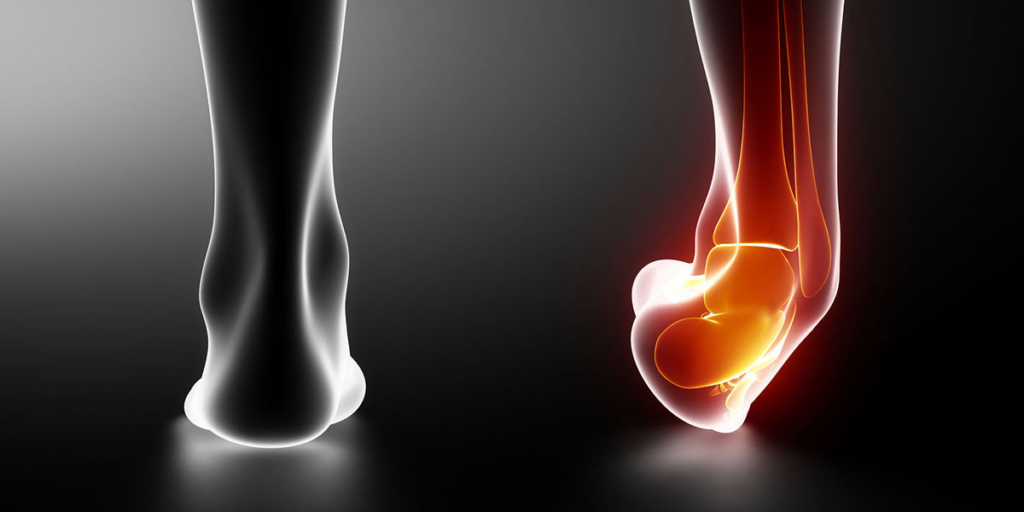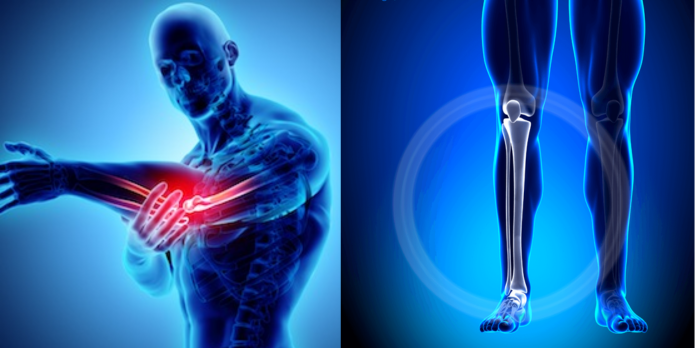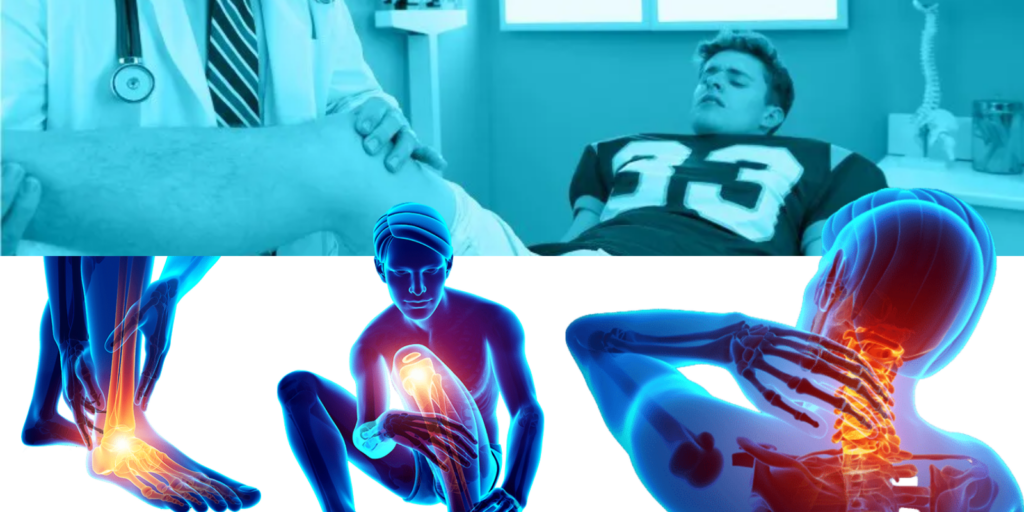Sports injuries are injuries that occur while a sport or any physical activity. It ranges from mild to severe and can injure parts such as muscles, ligaments, tendons, bones, cartilage, or the whole joint. The reason behind sports injuries could be an accident, collision, overuse, repetitive use, improper technique, or improper warm-up.
Examples of sports injuries
It includes muscle strain, sprains, bone fractures, concussions, dislocations, overuse injuries, and contusions. Soft tissue injury includes ligament tears, muscle tears, etc. All of these can have a high impact on quality of life because the symptoms they bring about lower the patient’s ability to participate in sports and conduct routine activities.

Sports injuries depend upon the type of sport, the level of competition, and many other factors. Here mentioned a list of a few types with descriptions:
· Sprains
Sprains are hurtful stretching of ligaments beyond their limit. Ligaments connect bones that may be torn as a result of unusual stretching. A most common example is ankle sprains during sports.
· Muscle strains
Tendons connect muscles to the bones, when the tendon or muscles are stretched too far or are torn this condition is called muscle strain. A common example is hamstring strains.
· Bone fracture
Fractures are breaks in bones and can range from mild hairline fractures to the complete shattering of bone into pieces. Common fractures encountered during sports or physical activity include wrist fractures, ankle fractures, knee fractures, elbow fractures, shoulder fractures, and stress fractures.
· Bone dislocation
When a bone is force out of its anchored position in a joint the condition is refer to as joint dislocation. Most commonly it occurs in contact sports, such as football or rugby.
· Contusions
Contusions also known as bruises cause by a direct hit on the body which causes bleeding under the skin or in the muscle.
· Concussions
Concussions are traumatic brain injuries that result from a hard blow to the head. They can occur in contact sports like football or hockey, as well as in other sports where falls or collisions are common.
· Tendonitis
Tendonitis is the inflammation of a tendon, often caused by repetitive movements or overuse. It commonly affects the elbows, shoulders, or knees.
· Overuse injuries
Overuse injuries result from repetitive stress on a specific body part, often caused by training excessively without giving proper rest to the muscles. Some examples of overuse injuries are:
- Runner’s knee
- Tennis elbow
- Shin splints.
· Rotator cuff injuries
These injuries affect the muscles and tendons that stabilize the shoulder joint. They can occur in sports that involve throwing, such as baseball or tennis.
· ACL injuries
ACL or anterior cruciate ligament found in the knee joint. ACL injuries usually occur in sports where a person has to suddenly stop, change direction, or jump. People playing soccer or basketball are more liable to get an ACL injury. The ACL may just sprain or tear causing pain and swelling in the knee joint.
A treatment plan for sports injuries
Whether it is a soft tissue injury or an injury occurring to the bone, the treatment plan is developed by looking at the severity of the injury. Here are mentioned some treatment methods to cure sports injuries:
- For mild injuries, RICE therapy is recommended by an orthopedist which includes:
- Rest: It is essential to boost the healing process and prevent further damage. A proper repair of an injury is made through complete rest. Resting means either reducing the activity that put stress on the injured part or immobilizing the part to ensure complete rest.
- Ice: applying ice to the injury help to lessen swelling, pain, and inflammation. Healthcare advisors usually recommend applying ice for about 15-20 minutes after a few hours in the initial stages of recovery.
- Compression: wrapping an elastic bandage around an injured joint, and putting compression sleeves or a brace will apply gentle pressure that supports the injured area and control swelling.
- Elevation: Put cushions or pillows beneath to elevate the injured limb above your heart level as it helps reduce swelling.
- Oral medicines such as painkillers and anti-inflammatory drugs are prescribed to manage pain and inflammation due to sports injuries. If pain doesn’t go away consult your orthopedist about the dosage.
- Rehabilitation exercises or sports physiotherapy are recommended after a few days to boost healing, improve joint range of motion, and strengthen muscles of the injured part.
- An injured limb or joint may be immediately immobilized using a splint, plaster cast, or brace to prevent it from moving and allow the injury to heal properly. Especially in case of a fracture or a soft tissue injury such as a sprain.
- Under severe conditions when non-surgical methods don’t work, surgery is conducted to make a repair. An orthopedist carefully diagnoses the injury and determines if surgical repair is needed or not.

Measure to take to prevent sports injuries
Preventions are advised by the orthopedist to take before any sports because it keep you safe from injuries and if injury occurs, it won’t be severe. Here are some general tips to help prevent sports injuries.
- Warm-up exercises should be done before the main sports or fitness training exercises. This may include light cardiovascular activities and stretching muscles.
- Use the proper technique for your sports which could be best guide by the trainer. Follow his instructions on the right postures to make, body mechanics, and movement patterns. Poor techniques increase the risk of sports injuries.
- Wear appropriate protective gear and equipment during sports or activities, such as using a helmet, knee, and elbow pads while cycling or riding a bike. Other equipment could be goggles, mouthguards, supportive footwear, etc. All the protective gear or equipment should be in good condition and must serve their purpose properly.
- Avoid abrupt increases in the intensity and duration of workouts. Gradual increase is appreciable because the body can adapt to the changes slowly and decreases the risk of getting sports injuries.
- Try different sports after a certain time because sticking to the same sport the whole year could lead to overuse injuries. Choose activities that help to promote the overall strength of the body rather than focusing on specific parts. Cross-training help balances the whole body’s strength and reduces the risk of muscle strains.
- Proper hydration is essential to enhance performance and to prevent muscle fatigue. Drink plenty of water to stay hydrated all the time especially between sports activities.
- Maintain a proper balance between rest and work. If you feel pain, discomfort or fatigue leave everything and take a rest. Don’t push yourself to work beyond your stamina as it may cause an injury.
- If you are new to a sport or activity and having specific concerns, seek guidance from a coach, trainer, or sports medicine specialist. They can provide valuable instructions, personalized advice, and guidance to prevent sports injuries.
Extract of discussion
The severity of sports injuries varies and their treatment is made accordingly. Mild cases are handle through non-surgical methods while some austere ones need surgical repair. It’s advisable to seek immediate medical attention for on-time diagnosis and appropriate treatment. Also, observe preventive measures to reduce the risk of getting a sports injury.

FAQs
Why sports injury management is important?
Sports injury management is important to promote timely recovery, prevent further deterioration, restore function, address psychological well-being, and optimize performance in the field. For athletes sports injury management is essential as it supports them in their journey to remain physically fit, ensure a quick recovery and return to sports soon.
What are the reasons for sports injuries?
Multiple factors can lead to sports injuries such as:
- A hard blow, accident, or contact with a hard surface.
- Repetitive or overuse of a certain part
- Failing to properly warm up the body before engaging in sports activities.
- Use of improper or poor technique during sports
- Inadequate rest
- Not allowing the previous injury to heal completely
- Ignoring the use of protective gear and equipment
- Playing on an uneven surface.
Why are protective gear and equipment important while sports?
Protective gear and equipment such as helmets, pads, brace, and goggles are design to minimize the risk of sports injuries. Therefore, lack of or improper use of protective gear and equipment can leave you more liable for injuries. Make sure all the equipment should be in the best condition and functions properly.
Is bone dislocation a sports injury? Yes, bone dislocation is a sports injury that occurs when the bone is moved from its fixed position in the joint. A sudden impact, fall, trauma, collision, or direct blow during sports activities causes this condition which is probable in sports such as football, basketball, rugby, and martial arts. Moreover, in sports that involve repetitive joint motion such as badminton, gymnastics, or weight lifting, joint dislocations are probable.
You may also like
-
Buy Shilajit Online: A Modern Path to Ancient Wellness
-
The Best Shilajit Brands: A Complete Guide to Quality, Purity & Performance
-
Unlocking Nature’s Secret: The Best Place to Buy Shilajit
-
Unlocking Nature’s Ancient Secret Power of Himalayan Fresh Shilajit
-
Breast Augmentation in Dubai: A Journey Toward Confidence and Contour

